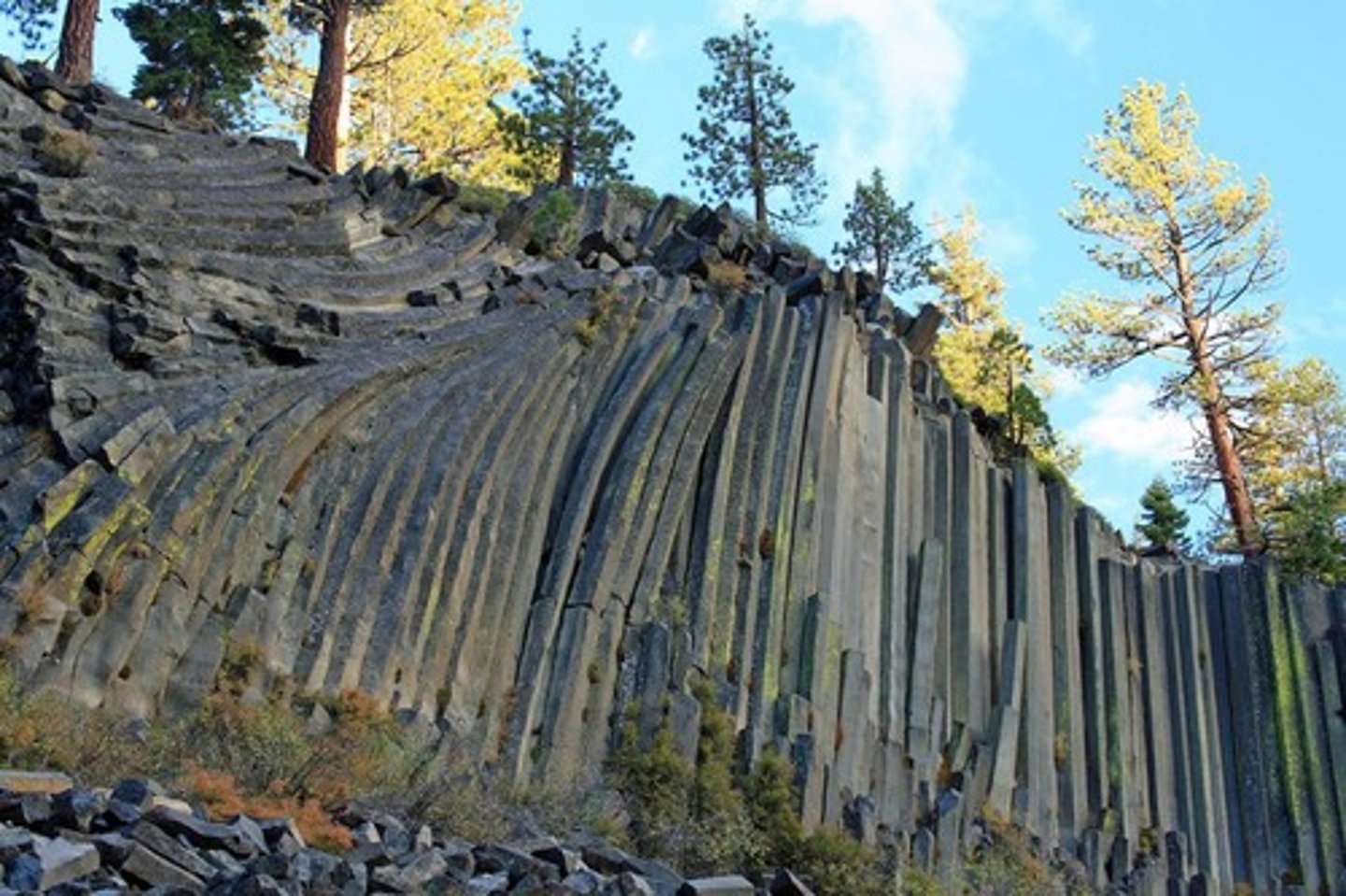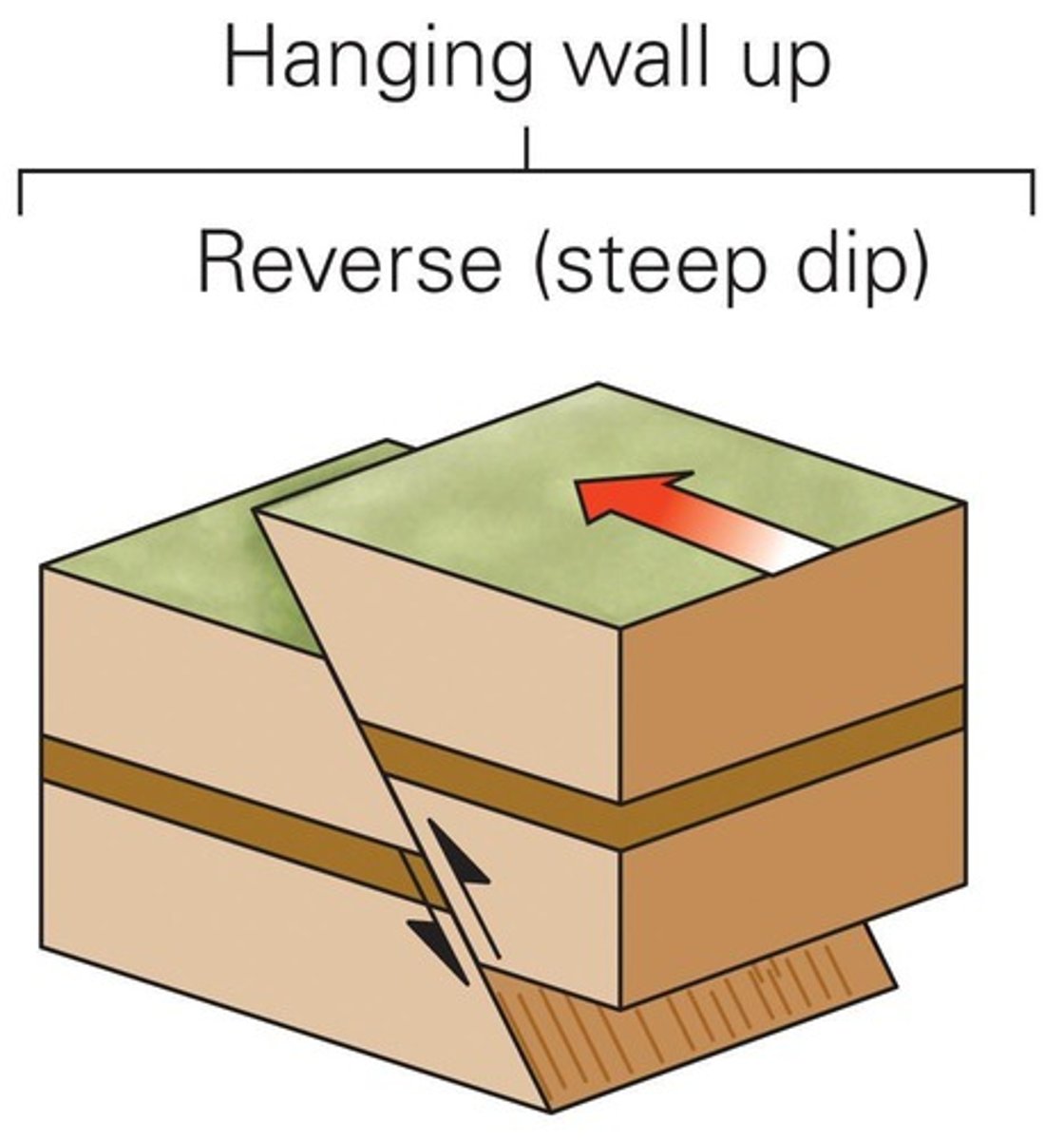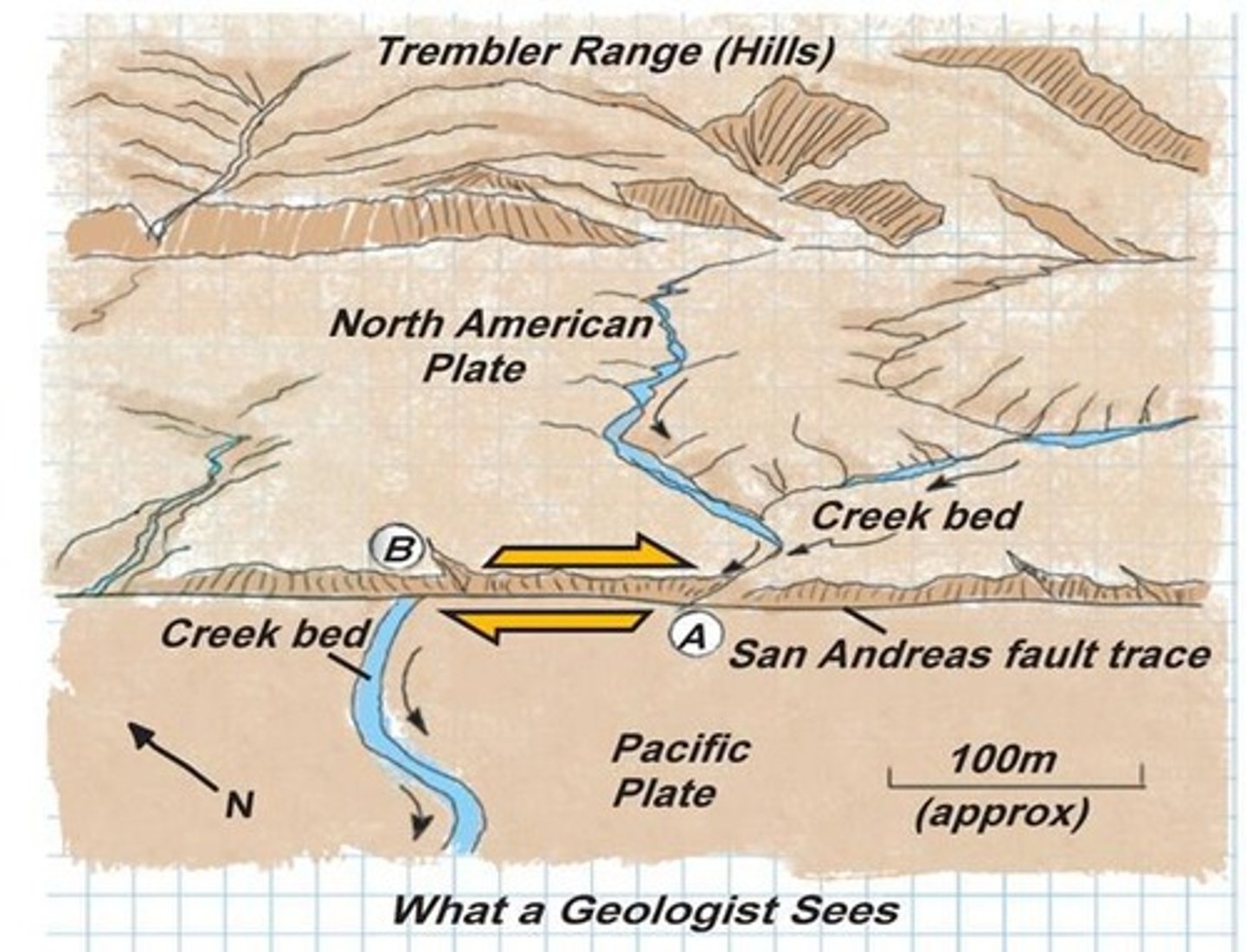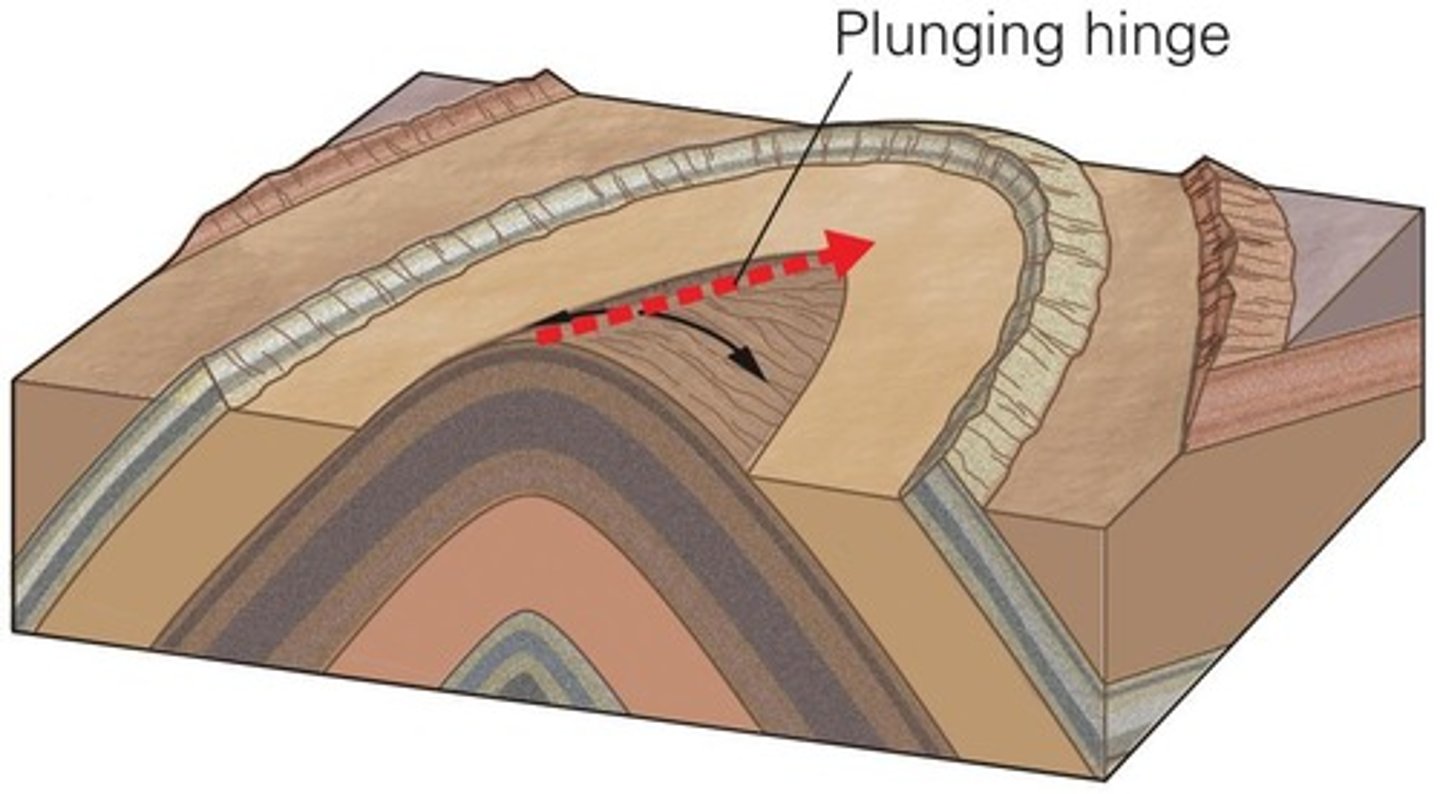Geology: Structural Features, Faults, Folds, and Earth's Interior
1/46
There's no tags or description
Looks like no tags are added yet.
Name | Mastery | Learn | Test | Matching | Spaced |
|---|
No study sessions yet.
47 Terms
What are brittle structures in geology?
Structures characterized by cracks where rock bodies do not slide past each other, created by changes in pressure.
What is columnar jointing?
A geological feature formed by contraction during cooling, resulting in polygonal columns, such as those found in Devil's Postpile, California.

What defines a fault in geology?
Fractures on which sliding occurs, with movement referred to as displacement and evidence of movement called offset.
What does the term 'foot wall' refer to in fault terminology?
The rock under a miner's feet in relation to a fault.
What is a normal fault?
A type of dip-slip fault where the hanging wall moves down relative to the foot wall.

What is a reverse fault?
A dip-slip fault with an angle greater than 30º, where the hanging wall moves up relative to the foot wall.

What is a thrust fault?
A type of dip-slip fault with an angle less than 30º, where the hanging wall is pushed up over the foot wall.

What characterizes strike-slip faults?
Faults where the movement is horizontal, with lateral displacement of rock bodies.

What is the San Andreas Fault?
A well-known strike-slip fault located in California, known for its significant geological activity.

What are ductile structures in geology?
Structures where layered rock is deformed into complex folds due to stress.
What is an anticline?
A folded structure that arches upward in the center, with limbs dipping away from the axial plane.

What is a syncline?
A folded structure that arches downward in the center, with limbs dipping towards the axial plane.
What is a plunging fold?
A fold where the hinge line plunges downward into the ground, rather than remaining horizontal.

What is a monocline?
A fold-like structure resembling a carpet draped over a stair step, where displacement does not reach the surface.
What is the difference between a dome and a basin in geological terms?
A dome is a fold that looks like an overturned bowl, while a basin is shaped like an upright bowl.
What is the role of convergent boundary deformation in mountain building?
It causes compressional stress that leads to crustal shortening and uplift in the overriding plate.
What occurs during continent-continent collision?
Formation of fold-thrust belts and high-grade metamorphism, as seen in the Himalayas.
What is continental rifting?
The process of splitting apart and stretching the crust, leading to normal faulting and the formation of deep sediment-filled basins.
What do geologic maps typically show?
Structures such as strike and dip, anticlines, synclines, faults, and rock formations.
What is 'strike' in geology?
The compass direction of a line formed by the intersection of a horizontal plane with a dipping bed.
What is 'dip' in geological terms?
The angle between the surface horizontal plane and the inclined rock layer.
How is strike and dip represented on a map?
Using 'T' shapes, where the long line indicates the strike direction and the short line indicates the dip angle.
What is geophysics?
The study of seismic waves, magnetism, gravity, and other physical characteristics of the Earth to understand the planet's character and behavior.
What are the three main layers of the Earth as understood in the 19th century?
Crust, mantle, and core.
What type of rock primarily composes the continental crust?
Felsic rock.
What type of rock primarily composes the oceanic crust?
Mafic rock.
What type of rock does the mantle consist of?
Ultramafic rock, specifically peridotite.
What are the two components of the Earth's core?
Outer core (liquid) and inner core (solid).
What are xenoliths?
Occasional pieces from below that reach the surface.
What is the significance of the Moho Line?
It is the boundary between the crust and the mantle, located about 25-70 km beneath continents and 7-10 km beneath oceans.
What are P-waves?
Compressional body waves that can travel through solids and liquids.
What are S-waves?
Shear body waves that can only travel through solids.
What are R-waves?
Raleigh surface waves that cause the ground to ripple up and down.
What are L-waves?
Love surface waves that cause the ground to ripple back and forth.
What factors affect the velocity of seismic waves?
Density, rigidity, and compressibility of the material the wave is traveling through.
What is the Low-Velocity Zone?
A depth of 100-200 km below the lithosphere where wave speeds are relatively low due to partial melting of peridotite.
What is seismic tomography?
A technique that produces a 3-D image of seismic velocities in Earth's interior, similar to CT scans in medicine.
What does the shadow zone indicate?
A sharp density change at depth, as evidenced by the absence of P-waves at certain angles from an epicenter.
What did studies in the 1930s reveal about the Earth's core?
That the Earth has a liquid outer core and a solid inner core, inferred from P-waves bouncing off a surface within the core.
What is seismic reflection used for?
To collect reflections of seismic waves from surfaces below, providing insights into the geological structure, often used in petroleum geology.
What is the significance of the depth of the inner core-outer core boundary?
Determined to be at 5,155 km, indicating a transition from liquid to solid states within the core.
What is the travel time of seismic waves?
The time from when a wave leaves the focus until it is recorded on a seismogram.
How do waves behave when they cross a boundary between rock types?
Their velocity changes, and they can be reflected or refracted depending on the properties of the materials.
What is the role of meteorites in understanding Earth's interior?
They are pieces of planetary interiors that provide insights into the composition of the Earth's core.
What is the primary method for studying the Earth's interior?
Analyzing seismic waves generated by earthquakes or artificial sources.
What is the crust-mantle boundary also known as?
The Moho Line.
What happens to seismic wave velocity at depths between 410 km to 660 km?
The velocity increases in a step-wise fashion as atoms become more tightly packed within minerals.